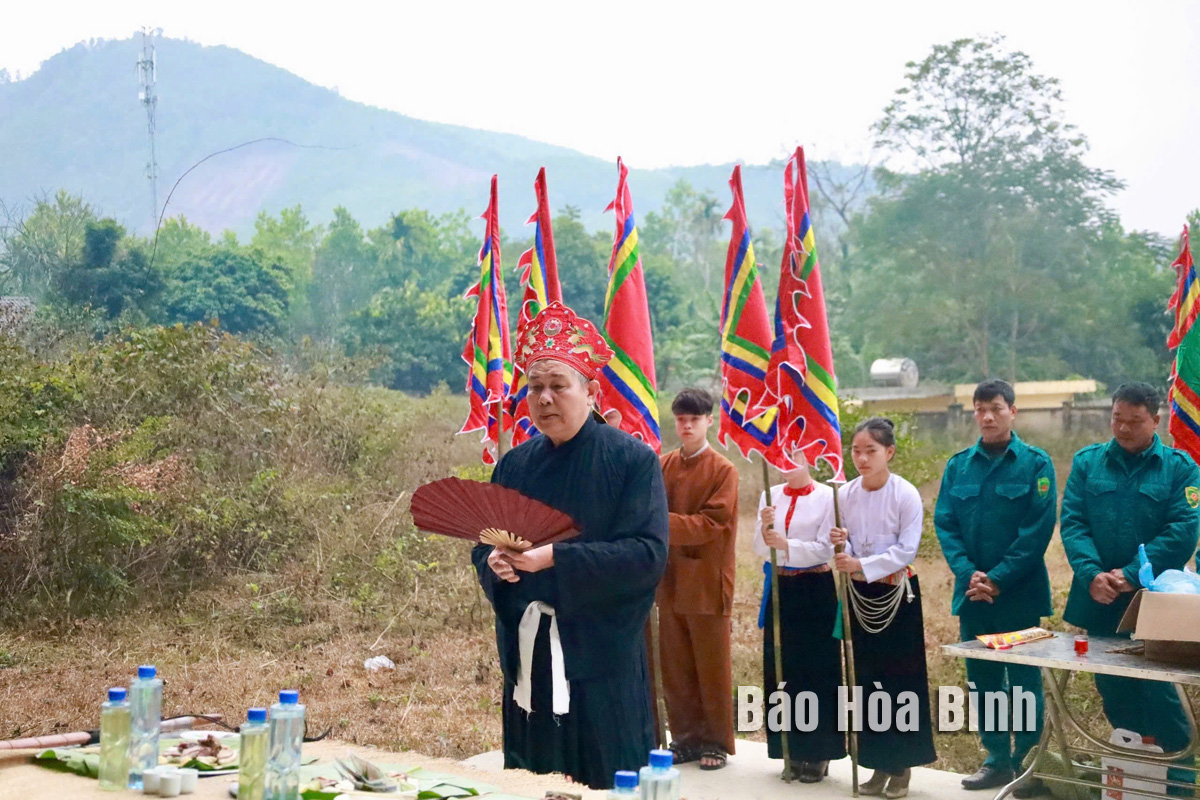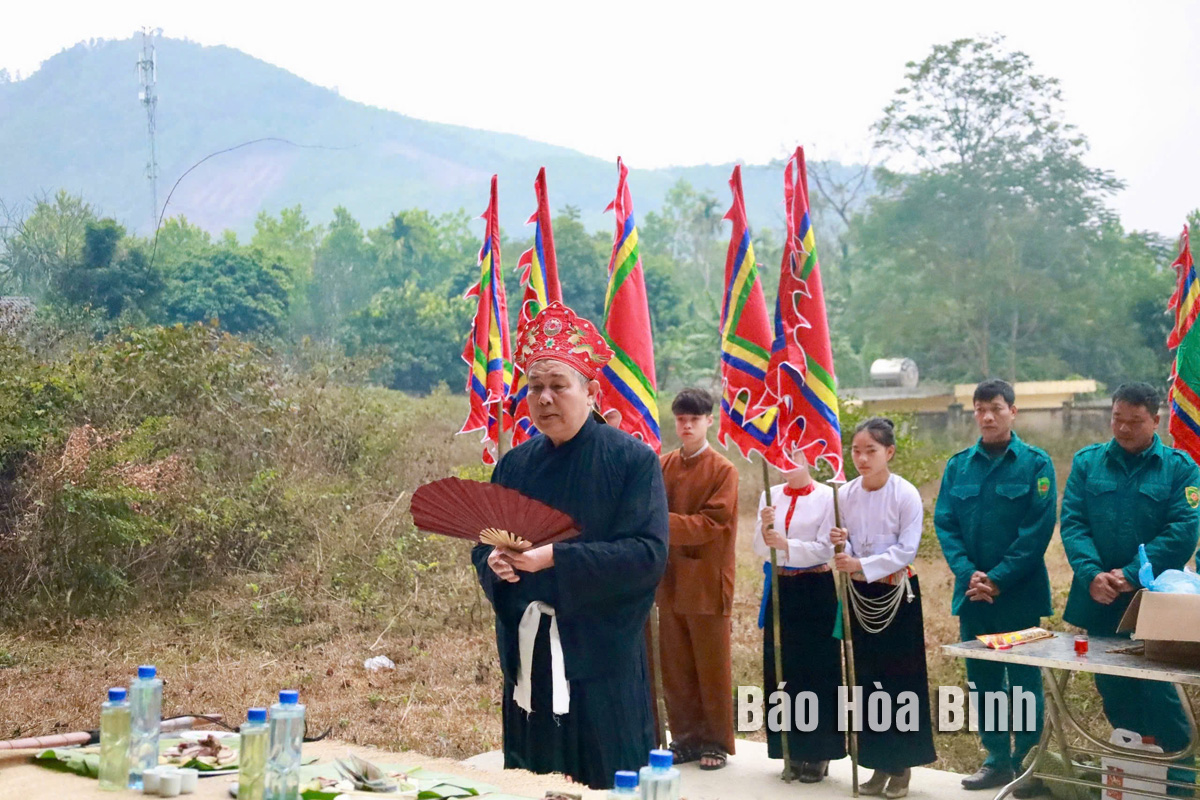
Mo is a term referring to a profession and cultural heritage which integrates folk beliefs with folk culture and arts. Practiced at funerals and religious rituals by the Muong ethnic people, it aims to provide spiritual comfort during significant life events such as illness and death.
Shaman Bui Van Sinh in Yen Phu commune, Lac Son district performs
Mo Muong rituals at Mai da lang vang (the stone roof of Vanh village).
Mo Muong is the Muong people's unique and
significant cultural heritage which leaves deep influences on many aspects of
their lives for generations. It embodies profound humanistic, cultural, and historical values, as well as the linguistic and literary traditions of the
Muong people. Mo Muong can be considered a "folk encyclopedia” on the ethnic
minority group. It consists of three main elements: wording, worship ritual,
and practitioners, with wording playing the most crucial role.
In general, Mo Muong is a collection of oral
verses that are passed down through generations. During rituals, a shaman
chants Mo verses and chapters in specific melodies that align with the content
and purpose of the ceremony.
Mo artisan is the person who performs these
sacred chants. Currently, there are approximately 200 Mo artisans in Hoa Binh
province. In Muong communities, they are highly respected and known as thay mo,
po mo, or ong au, but thay mo (shaman) is the most common title. Throughout
history, Mo practitioners have been spiritual pillars for the Muong people,
guiding them through life's uncertainties.
Mo profession refers to those who earn a living
through this practice. This job requires training, often passed down within
families. A distinctive feature of shamans' attire is their hats. In the Lac Son
district, when conducting funeral ceremonies, shamans wear hats shaped like two
forward-facing wild buffalo horns, symbolizing power and spiritual authority.
These red hats and their decorative bands are embroidered with sacred animals
such as turtles, dragons, phoenixes, birds, and fish each representing their
outlook on life. Shamans also carry khot, a fabric bag containing sacred
objects used for self-protection and warding off evil spirits during rituals.
Mo encapsulates the cultural essence of the
Muong people. Within its poetic verses, Mo preserves ancient folktales,
legends, myths, and epics. These narratives reflect history, explain natural
phenomena, and convey ancestral wisdom. Notably, Mo Muong serves as a vital
repository of the ancient Muong language. Many geographical names, plant
species, rivers, and streams mentioned in Mo Muong correspond to real places
within Muong territories, apart from mythological realms.
Moreover, Mo Muong reflects the Muong people’s
philosophy of life, their worldview and perceptions of the universe which is
believed to have three levels and five worlds, along with their production
experience, calendar, plant classification, and knowledge of interacting with
nature.
Mo Muong also embodies folk religious beliefs,
including ancestor worship, veneration of the progenitor of Mo, rituals for the
living, plant worship, and sacrifice rites, as seen in Mo buffalo, Mo cow, or
Mo chicken
Today, Mo continues to be cherished by the Muong
people. Despite adaptations in funeral practices, Mo rituals remain an
essential part of their traditions. The number of roong mo, similar to chapters
in literature, has been minimised, retaining only the most crucial ones for
ceremonial purposes. The values of Mo continue to accompany the Muong people into
the future as a foundational cultural element.
In 2015, Hoa Binh received the sponsorship of
the Vietnam Federation of UNESCO Associations for its Mo Muong. One year later,
the Minister of Culture, Sports and Tourism issued a decision adding it to the national
intangible cultural heritage list. In 2020, the Prime Minister ordered building
a dossier for Mo Muong seeking its inclusion in the UNESCO List of Intangible
Cultural Heritage in Need of Urgent Safeguarding. These developments further
highlight the enduring significance of Mo Muong as a treasured cultural
heritage.
Preserving and promoting the cultural values of the Muong ethnic group has become an urgent task in the current context, as many traditional values face the risk of fading away. This effort requires not only protecting the cultural identity but also eliminating outdated customs and developing a modern cultural lifestyle, contributing to sustainable values for the Muong community in Hoa Binh province.
The Muong ethnic culture, deeply rooted in Vietnam’s mountainous north, continues to be preserved and revitalised by dedicated individuals and communities determined to safeguard their ancestral identity.
The Muong group is one of the largest ethnic minorities in Vietnam, primarily found in Hoa Binh province. The Muong people in Hoa Binh boast a rich and diverse cultural treasure that reflects the unique identity of this ethnic group. Accounting for over 63% of the province's population, they have created and preserved numerous distinctive cultural values, contributing to their unique identity. Their cultural heritage is an invaluable asset, at the heart of their national identity, and represents a vibrant spiritual life that must be preserved and promoted in today’s modern world.
For generations, the ethnic communities of Hoa Binh province, particularly the Muong people, have preserved vibrant festivals deeply intertwined with the region’s geography, nature, and social traditions. These celebrations enrich Hoa Binh’s spiritual life and cultural identity, reflecting both folk beliefs and the intermingling of ethnic customs. Many of these festivals have endured the test of time, passed down through generations and continuing to thrive today. Among them, the Khai Ha (Going Down to the Field) festival stands out as one of the most significant events of the Muong ethnic group.
Muong calendar, known as sach doi, is an ancient folk knowledge system developed through observations of the movement of the pleiades star. This unique calendar consists of 12 bamboo sticks, each representing a lunar month. Specific days within each month are marked with distinct symbols, guiding locals in determining auspicious and inauspicious days for important activities.
Authorities and residents of Chieng Chau commune, Mai Chau district, are making efforts to preserve and promote the historical value of a centuries-old gold apple tree (scientifically known as diospyros decandra lour), which has been recognised as a national heritage tree.



